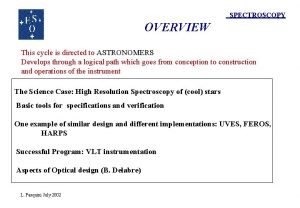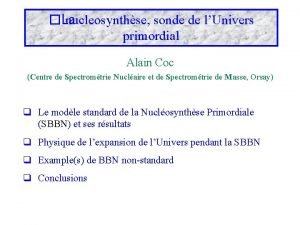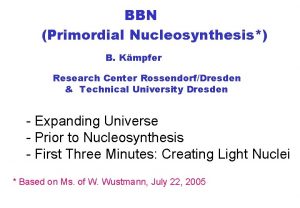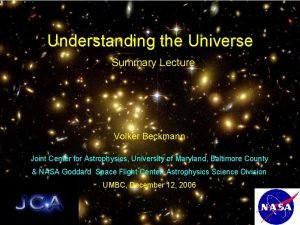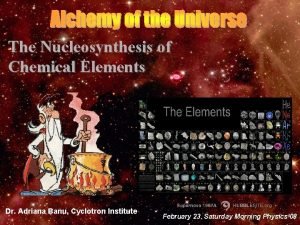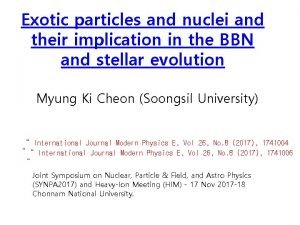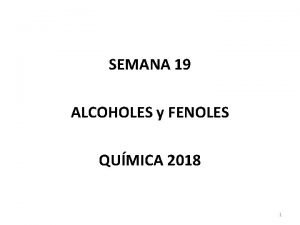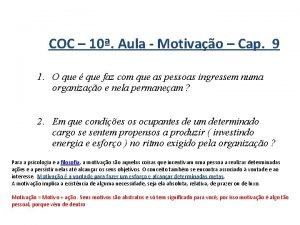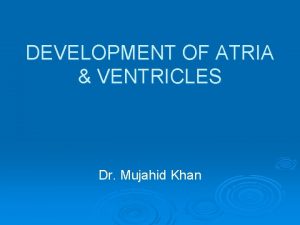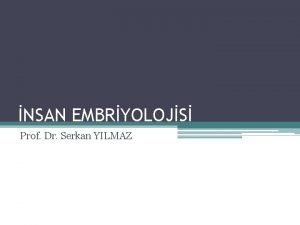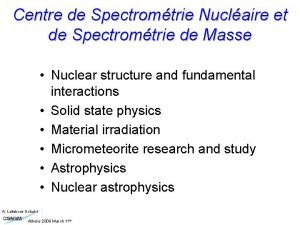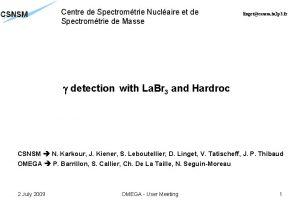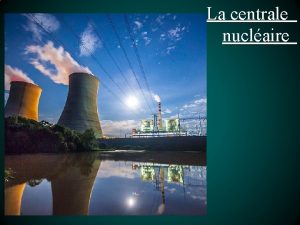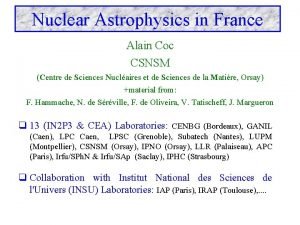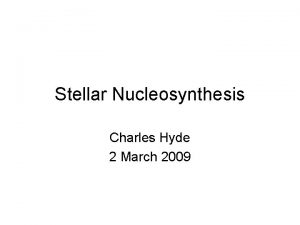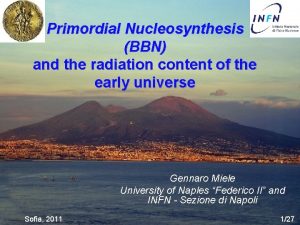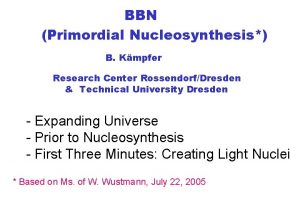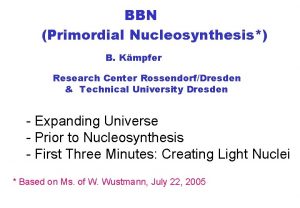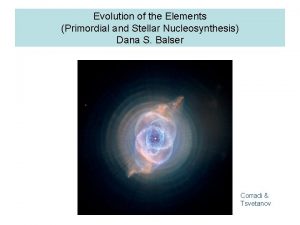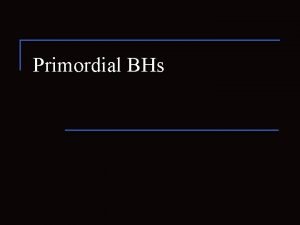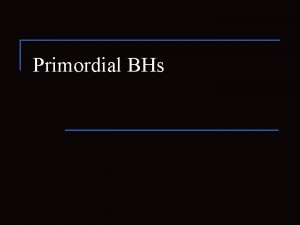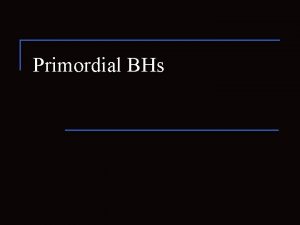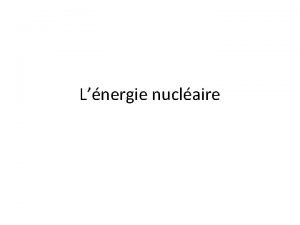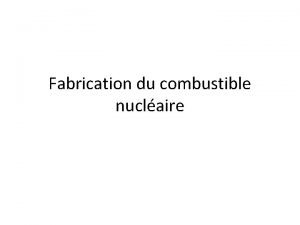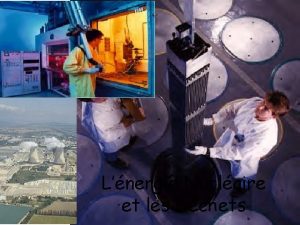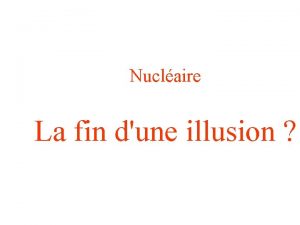Primordial Nucleosynthesis Alain Coc Centre de Spectromtrie Nuclaire



![Sensitivity to thermonuclear reaction rates At WMAP baryonic density 10 [Coc & Vangioni 2010] Sensitivity to thermonuclear reaction rates At WMAP baryonic density 10 [Coc & Vangioni 2010]](https://slidetodoc.com/presentation_image_h2/f92735604313acb23e9711787a5ce686/image-4.jpg)







![Other resonances ? [Chakraborty, Fields & Olive (2011)] Unknown Resonances in 7 Be + Other resonances ? [Chakraborty, Fields & Olive (2011)] Unknown Resonances in 7 Be +](https://slidetodoc.com/presentation_image_h2/f92735604313acb23e9711787a5ce686/image-12.jpg)



![6 Li nucleosynthesis after GSI experiment [See also Poster 9] Coulomb dissociation of 6 6 Li nucleosynthesis after GSI experiment [See also Poster 9] Coulomb dissociation of 6](https://slidetodoc.com/presentation_image_h2/f92735604313acb23e9711787a5ce686/image-16.jpg)



![Monte-Carlo BBN versus observations Number of atoms 13 reactions Monte. Carlo † [CV 2010] Monte-Carlo BBN versus observations Number of atoms 13 reactions Monte. Carlo † [CV 2010]](https://slidetodoc.com/presentation_image_h2/f92735604313acb23e9711787a5ce686/image-20.jpg)





- Slides: 25

Primordial Nucleosynthesis Alain Coc (Centre de Spectrométrie Nucléaire et de Spectrométrie de Masse, Orsay) q Standard Big-Bang Nucleosynthesis of 4 He, D, 3 He, 7 Li compared with observations q The SBBN “lithium problems”: nuclear aspects q (6 Li, 9 Be , 10, 11 B) and CNO in extended SBBN network q Neutron injection and the lithium problem

The 12 reactions of standard BBN Ø 10 thermonuclear reaction rates deduced from experimental data Ø First 2 from theory: weak n p rate and p(n, )d T>10 GK Ø Additional 400 reactions up to CNO ⇒ T<1 GK Standard BBN Ø No convection Ø No diffusion Ø No mixing Ø Known physics Ø <12 reactions Simple nucleosynthesis (? )

n p weak reaction rates n p∝ n-1 å (phase space) (e distribution) ( e distribution) d. E + small corrections The neutron lifetime is still a matter of debate (but not essential to BBN) n = 885. 7 0. 8 s [PDG 2008] or n=878. 5 0. 7 0. 3 s [Serebrov et al. 2005] 881. 5 ± 1. 5 s [PDG 2011] ; 880– 884 s [Wietfeldt & Greene 2011] • Weak rate change mostly affects n/p ratio at freeze out and hence 4 He abundance • Change in expansion rate gives similar effect (n/p freezeout when weak rate expansion rate)
![Sensitivity to thermonuclear reaction rates At WMAP baryonic density 10 Coc Vangioni 2010 Sensitivity to thermonuclear reaction rates At WMAP baryonic density 10 [Coc & Vangioni 2010]](https://slidetodoc.com/presentation_image_h2/f92735604313acb23e9711787a5ce686/image-4.jpg)
Sensitivity to thermonuclear reaction rates At WMAP baryonic density 10 [Coc & Vangioni 2010] ln(Y) / ln(NA< v>) E 0( E 0/2) (Me. V @ 1 GK) Reaction 4 He D 3 He 7 Li n (n p) 0. 73 0. 42 0. 15 0. 40 1 H(n, )2 H 0 -0. 20 0. 08 1. 33 0. 025 2 H(p, )3 He 0 -0. 32 0. 37 0. 57 0. 11(0. 11) 2 H(d, n)3 He 0 -0. 54 0. 21 0. 69 0. 12(0. 12) 2 H(d, p)3 H 0 -0. 46 -0. 26 0. 05 0. 12(0. 12) 3 H(d, n)4 He 0 0 -0. 01 -0. 02 0. 13(0. 12) 3 H( , )7 Li 0 0. 03 0. 23(0. 17) 3 He(n, p)3 H 0 0. 02 -0. 17 -0. 27 3 He(d, p)4 He 0 0. 01 -0. 75 0. 21(0. 15) 3 He( , )7 Be 0 0. 97 0. 37(0. 21) 7 Li(p, )4 He 0 0 0 -0. 05 0. 24(0. 17) 7 Be(n, p)7 Li 0 0 0 -0. 71

10 rates deduced from experimental data Compilations and evaluations for/including BBN thermonuclear rates Ø Smith, Kawano & Malaney 1999 (with uncertainties) Ø NACRE, Angulo et al. 1999 (7/10, tabulated rates and uncertainties) Ø Nollett & Burles 2000 (no rates provided) Ø Cyburt, Fields & Olive 2003 (revaluation of NACRE) Ø Serpico et al. 2004 (rates and uncertainties provided) Ø Descouvemont, Adahchour, Angulo, Coc & Vangioni-Flam 2004 [DAACV] • « R-Matrix » formalism: S-factors fits of data constrained by theory • Provide also reaction rate uncertainties Ø Cyburt 2004 (rates provided, uncertainties calculated but not provided) Ø Update with post 2004 experimental data yet to be done…

The 1 H(n, )2 H reaction Sensitivity = 1. 33 E ~ 25 ke. V New measurement of the M 1 contribution [Ryezaveva et al. 2006] by inelastic electron scattering off D New precise n(p, )d EFT cross section and rate calculation [Ando et al. 2006] Variation of constants (K. Olive talk)

The 2 H(d, n)3 He reaction Sensitivity = 0. 61 E 0( E 0/2) = 0. 12(0. 12) Me. V New precise measurements of 2 H(d, n)3 He (and 2 H(d, p)3 H) reaction at TUNL [Leonard et al. 2006] Excellent agreement with DAACV 2004 fit within Gamow window Ø No change in central Li/H value Ø Reduced uncertainty Ø R-matrix fit reliability

The 3 He( , )7 Be reaction Sensitivity = 0. 97 E 0( E 0/2) = 0. 37(0. 21) Me. V Systematic uncertainties : prompt versus activation measurements New precise measurements : Ø Prompt [Brown et al. 2007, Confortola et al. 2007, Costantini et al. 2008] Ø Activation [Nara Singh et al. 2005, Brown et al. 2007, Confortola et al. 2007, Gyürky et al. 2007] Ø Recoil [Di Leva et al. 2009] Reanalysis of 3 He( , )7 Be rate [Cyburt & Davids 2008]: S(0) = 0. 580± 0. 043 ke. V. b (13% higher than in DAACV 04) S(0) = 0. 56± 0. 02 ke. V. b [Adelberger et al. 2010] [DAACV]

Determination of primordial abundances Primordial abundances : 1) Observe a set of primitive objects born when the Universe was young 2) Extrapolate to zero metallicity : Fe/H, O/H, Si/H, …. 0 • • 7 Li at the surface of low metallicity stars in the halo of our Galaxy: Li/H = (1. 58± 0. 35) 10 -10 [Sbordone et al. 2010] 4 He in H II (ionized H) regions of blue compact galaxies: 0. 245 < Yp < 0. 267 [Aver, Olive & Skillman 2010] (0. 245 < Yp < 0. 262 [Skillman, this workshop]) • D in remote cosmological clouds (i. e. at high redshift) on the line of sight of quasars: (2. 84± 0. 26)× 10 -5 (1 - ) [Fields & Sarkar 2008] • 3 He in H II regions of our Galaxy: 3 He/H ≤ (1. 1± 0. 2)× 10 -5 [Bania et al. 2002]

The Li problem update q. New nuclear data q New abundance determinations q Agreement for 4 He, D and 3 He q 7 Li difference of a factor of > 3 ! BBN calculations Cyburt et al. 2008 Coc & Vangioni 2010 4 He 0. 2486± 0. 0002 0. 2476± 0. 0004 D/H 2. 49± 0. 17 2. 68± 0. 15 3 He/H 1. 00± 0. 07 1. 05± 0. 04 7 Li/H 5. 24+0. 71 -0. 62 5. 14± 0. 50

New 7 Be (i. e. 7 Li) destruction channels 30 100 300 1000 Ø The 7 Be(d, p)8 Be* 2 reaction [Coc et al. 2004] • Experiment at Louvain LN [Angulo et al. 2005] : no (integrated) cross-section enhancement • Hypothetical resonance at ER = 200± 100 ke. V with 40 ke. V [Cyburt & Pospelov 2009]; corresponding to ≈16. 7 Me. V 9 B level ? • No resonance observed at Oak Ridge in D(7 Be, d)7 Be scattering [O’Malley et al. 2011] • Measured Ex=16. 8 Me. V and =81 ke. V [Scholl et al. 2011] ⇒primordial effect on 7 Li < 4% [Kirsebom & Davids 2011]
![Other resonances Chakraborty Fields Olive 2011 Unknown Resonances in 7 Be Other resonances ? [Chakraborty, Fields & Olive (2011)] Unknown Resonances in 7 Be +](https://slidetodoc.com/presentation_image_h2/f92735604313acb23e9711787a5ce686/image-12.jpg)
Other resonances ? [Chakraborty, Fields & Olive (2011)] Unknown Resonances in 7 Be + n, p, d, t, 3 He and ? 8 Be, 9, 10, 11 B, 10, 11 C compound nuclei Unknown level properties in 9, 11 B and unknown levels in 10 C 16. 50 15. 00 7 Be+3 He (2+) 15. 04 (2 -, 1 -) ? 14. 99 (2 -, 1 -) ? 10. 00 7 Be+3 He→ 10 C→ 2 p+2 10 C level structure investigated trough other reactions e. g. 9. 000 6. 580 5. 220 (2+) 3. 353 2+ p ? 5. 10 9 Be+3 He→ 10 C+d 10 C 9 B+p 6 Be+

g n i go On Proposed Tandem Experiment Indirect study of 10 C, 9 B & 10 B states via (3 He, t), (3 He, d) reactions on 10 B and 9 Be targets. B (pos). E. E ORSAY SPLIT-POLE spectrometer particle identification t or d Position gas chamber DSSDs 3 He E proportional counter @ 35 Me. V 10 B, 9 Be targets 100 g/cm 2 Plastic scintillator (E) © F. Hammache

First results from Tandem experiment New 10 C level: • • • E x= ΓTot = Spin-parity ? Partial widths ? Experiment in progress [F. P Ha rov is m ma che ion , pr al ! iv. com But unlikely to contribute m. ] (Coulomb barrier) [Broggini et al. Ar. Xiv: 1202. 5232 and Poster 5]

6 Li nucleosynthesis • 4 He(t, n)6 Li, 7 Li(p, d)6 Li • 3 He(t, )6 Li : Q ≈ -5 Me. V : too slow [Fukugita & Kajino, 1990] Conservative range of 6 Li/H observations [Nissen et al. 1999; Cayrel, et al. 1999; Aoki et al. 2004; Asplund et al. 2006] Uncertainty from 2 H( , )6 Li [NACRE 1999]
![6 Li nucleosynthesis after GSI experiment See also Poster 9 Coulomb dissociation of 6 6 Li nucleosynthesis after GSI experiment [See also Poster 9] Coulomb dissociation of 6](https://slidetodoc.com/presentation_image_h2/f92735604313acb23e9711787a5ce686/image-16.jpg)
6 Li nucleosynthesis after GSI experiment [See also Poster 9] Coulomb dissociation of 6 Li at GSI γ* : virtual photon in the [Hammache et al. 2011] 6 Li + γ* → 4 He + D vicinity of high Z nucleus The nuclear dissociation contribution is important and was dominant in previous experiment! HD 84937 : Cayrel, et al. 2008; Steffen et al. 2010 BBN 6 Li BBN production 6 Li/H ≈ 1. 3× 10 -14 [Hammache et al. 2011]

CNO nucleosynthesis with an extended BBN network q Extended to CNO network predictions : CNO/H ≈ 10 -15 [Iocco et al. 2007] q Motivation for extended network: Ø Potential neutron sources for 7 Be destruction by 7 Be(n, p)7 Li(p, )4 He in BBN; unexpected effect (e. g. 7 Li sensitivity to n(p, γ)d) Ø CNO seeds for first (Population III) stars : CNO/H > 10 -11 [Cassisi & Castellani 1993]; CNO/H > 10 -13 [Ekström et al. 2008] Ø Standard CNO primordial abundances versus exotic production (e. g. “variation of fundamental constants”) Ø Future observations CNO ?

CNO nucleosynthesis updated network ØInvolves many (>400), AZ + n, p, d, t, 3 He and , reactions Ø Mostly unknown rates hence possibly high yield uncertainty Ø Origin of rates in previous works: unclear! Z A n 1 H 1 -3 He 3, 4, 6 Li 6 -9 Be 7, 9 -12 B 8, 10 -15 C 9 -16 N 12 -17 O 13 -20 F 17 -20 Ne 18 -23 Na 20 -23 Ø 59 isotopes Ø 33 decay rates [Audi et al. 2003] Ø 391 reaction rates ü Experimental rates [CF 88, NACRE I, Descouvemont et al. 2004, NACRE II, Iliadis et al. 2010, …. ] ü Theoretical rates for Z≥ 3 Talys (271 rates) within 3 orders of magnitude, at T=1 GK, compared with experiments!

CNO nucleosynthesis q Systematic test of yield sensitivities to up to 10 -3 -103 rate variations Ø Identification of important reactions for A>7 yields Ø Analysis of available experimental and theoretical data new rates and limits [Coc, Goriely, Xu, Saimpert & Vangioni 2012]
![MonteCarlo BBN versus observations Number of atoms 13 reactions Monte Carlo CV 2010 Monte-Carlo BBN versus observations Number of atoms 13 reactions Monte. Carlo † [CV 2010]](https://slidetodoc.com/presentation_image_h2/f92735604313acb23e9711787a5ce686/image-20.jpg)
Monte-Carlo BBN versus observations Number of atoms 13 reactions Monte. Carlo † [CV 2010] 424 reactions Network †† [Coc et al. 2012] 0. 2476± 0. 0004 0. 2476 D/H( 10 -5) 2. 68± 0. 15 2. 59 3 He/H( 10 -5) 1. 05± 0. 04 1. 04 7 Li/H( 10 -10) 5. 14± 0. 50 5. 24 6 Li/H( 10 -14) 1. 3* 1. 2 4 He (Yp) *Hammache et al. 2010, Ωbfrom Spergel et al. 2007† or Komatsu et al. 2011†† Number of atoms [Iocco et al. 2007] [Coc et al. 2012] (12 C+13 C)/H ( 10 -16) 5. 5 6. 75 (14 C+14 N)/H ( 10 -17) 5. 0 6. 76 2. 7 9. 13 6. 0 7. 43 16 O/H ( 10 -20) CNO/H ( 10 -16)

Counter intuitive effects in BBN Ø The 1 H(n, )D reaction affects mostly 7 Li : neutron abundance Ø The 7 Li(d, n)24 He reaction affects strongly the CNO but leaves 7 Li (and other isotopes) unchanged! Ø Systematic sensitivity studies are important

Dark matter neutron injection Small increase in neutron abundance reduces 7 Be (7 Li) production without affecting much 4 He, D and 3 He Extra source of neutrons from Dark Matter ? Ø Dark Matter decay: χ → n + …. λ→n∝λ 0 exp(-t/τχ) Ø Dark Matter annihilation: χ+χ → n + …. λ→n∝λ 0 a(t)-3 (dilution ∝(T/TC)3) [Albornoz Vásquez, Belikov, Coc, Silk & Vangioni, submitted]

Dark matter injection of thermal neutrons q Thermalization of neutrons on shorter time-scale than ü Expansion rate ü Neutron lifetime q Energy loss ü From multiple scattering rather than single collision q Negligible spallation ü No 6 Li overproduction by spallation reactions: 1. n + 4 He → 3 He + 2 n 2. 4 He + 3 He → 6 Li + p Achievable for Mχ in the 1 to 30 Ge. V range

Representative results 1. Neutron injection at constant rate 2. Neutron injection from decay with τχ = 40 mn 3. Neutron injection from annihilation with TC = 0. 3 GK Alleviates the 7 Li problem at the expense of D [Albornoz Vásquez, Belikov, Coc, Silk & Vangioni, submitted] ③ ① ②

Conclusions q SBBN calculations confirm good agreement between CMB and SBBN (D and 4 He). q However disagreement between Li observations, SBBN and CMB : Ø Nuclear (7 Li) : Very highly unlikely (extra neutron source? additional resonances e. g. in 7 Be+ [Broggini et al. Ar. Xiv: 1202. 5232 and Poster 5]) but important to quantify the amount of needed depletion. Ø Nuclear (6 Li) : No, 2 H( , )6 Li rate now experimentally well constrained ( 6 Li/H ≈ 1. 3× 10 -14); direct measurement at LUNA [Poster 9] Ø Stellar depletion ? Ø Particle physics/Cosmology (e. g. DM neutron source, variation of constants) q CNO/H in the range (0. 2 -3. ) × 10 -15 will not affect Pop. III stars q SBBN is now a parameter free model ! Ø Probe of the physics of the early Universe (K. Olive and T. Kajino talks)
 Primordial nucleosynthesis
Primordial nucleosynthesis Primordial nucleosynthesis
Primordial nucleosynthesis Primordial nucleosynthesis
Primordial nucleosynthesis Primordial nucleosynthesis
Primordial nucleosynthesis Abundance of elements
Abundance of elements Exotic nucleosynthesis
Exotic nucleosynthesis D.cscan.coç
D.cscan.coç Cộc cách tùng cheng
Cộc cách tùng cheng Coc barbaren
Coc barbaren Certificate of completion special education
Certificate of completion special education Coc religion
Coc religion Coc transformatives
Coc transformatives Thai.coc
Thai.coc Coi/coc
Coi/coc Coc luftabwehr
Coc luftabwehr Có công mài sắt có ngày nên kim chế
Có công mài sắt có ngày nên kim chế Một thùng hàng có 1250 cái cốc và chén
Một thùng hàng có 1250 cái cốc và chén C-o-c quimica
C-o-c quimica Coc marae
Coc marae Levonorgestrel
Levonorgestrel Dissatisfeito
Dissatisfeito Difference between centre of mass and centre of gravity
Difference between centre of mass and centre of gravity Difference between centre of gravity and centroid
Difference between centre of gravity and centroid Primordial atmosphere
Primordial atmosphere Partitioning of primordial ventricle
Partitioning of primordial ventricle Kumulus ooforus
Kumulus ooforus
